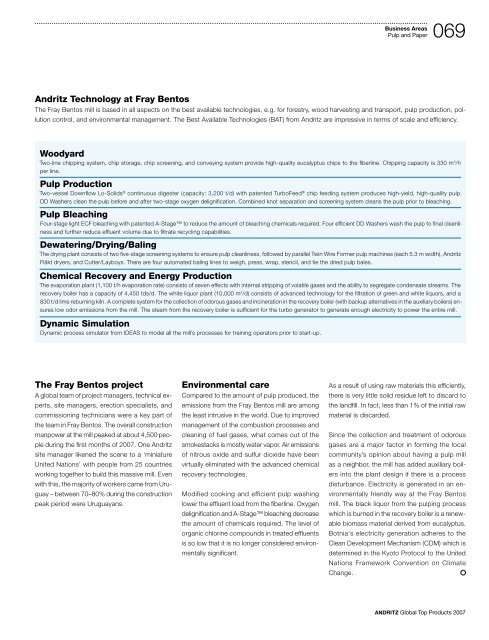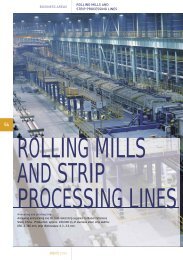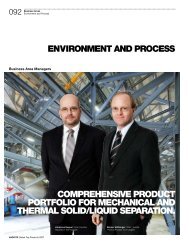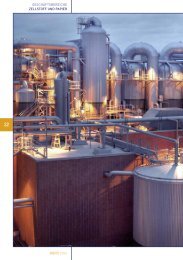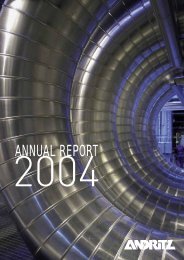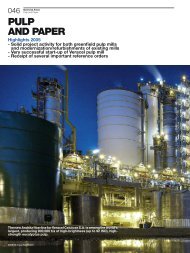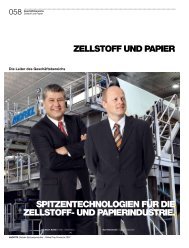Andritz Annual Report 2007 - andritz business areas
Andritz Annual Report 2007 - andritz business areas
Andritz Annual Report 2007 - andritz business areas
Create successful ePaper yourself
Turn your PDF publications into a flip-book with our unique Google optimized e-Paper software.
Business Areas<br />
Pulp and Paper<br />
069<br />
<strong>Andritz</strong> Technology at Fray Bentos<br />
The Fray Bentos mill is based in all aspects on the best available technologies, e.g. for forestry, wood harvesting and transport, pulp production, pollution<br />
control, and environmental management. The Best Available Technologies (BAT) from <strong>Andritz</strong> are impressive in terms of scale and efficiency.<br />
Woodyard<br />
Two-line chipping system, chip storage, chip screening, and conveying system provide high-quality eucalyptus chips to the fiberline. Chipping capacity is 330 m 3 /h<br />
per line.<br />
Pulp Production<br />
Two-vessel Downflow Lo-Solids ® continuous digester (capacity: 3,200 t/d) with patented TurboFeed ® chip feeding system produces high-yield, high-quality pulp.<br />
DD Washers clean the pulp before and after two-stage oxygen delignification. Combined knot separation and screening system cleans the pulp prior to bleaching.<br />
Pulp Bleaching<br />
Four-stage light ECF bleaching with patented A-Stage to reduce the amount of bleaching chemicals required. Four efficient DD Washers wash the pulp to final cleanliness<br />
and further reduce effluent volume due to filtrate recycling capabilities.<br />
Dewatering/Drying/Baling<br />
The drying plant consists of two five-stage screening systems to ensure pulp cleanliness, followed by parallel Twin Wire Former pulp machines (each 5.3 m width), <strong>Andritz</strong><br />
Fläkt dryers, and Cutter/Layboys. There are four automated baling lines to weigh, press, wrap, stencil, and tie the dried pulp bales.<br />
Chemical Recovery and Energy Production<br />
The evaporation plant (1,100 t/h evaporation rate) consists of seven effects with internal stripping of volatile gases and the ability to segregate condensate streams. The<br />
recovery boiler has a capacity of 4,450 tds/d. The white liquor plant (10,000 m 3 /d) consists of advanced technology for the filtration of green and white liquors, and a<br />
830 t/d lime reburning kiln. A complete system for the collection of odorous gases and incineration in the recovery boiler (with backup alternatives in the auxiliary boilers) ensures<br />
low odor emissions from the mill. The steam from the recovery boiler is sufficient for the turbo generator to generate enough electricity to power the entire mill.<br />
Dynamic Simulation<br />
Dynamic process simulator from IDEAS to model all the mill’s processes for training operators prior to start-up.<br />
The Fray Bentos project<br />
A global team of project managers, technical experts,<br />
site managers, erection specialists, and<br />
commissioning technicians were a key part of<br />
the team in Fray Bentos. The overall construction<br />
manpower at the mill peaked at about 4,500 people<br />
during the first months of <strong>2007</strong>. One <strong>Andritz</strong><br />
site manager likened the scene to a ‘miniature<br />
United Nations’ with people from 25 countries<br />
working together to build this massive mill. Even<br />
with this, the majority of workers came from Uruguay<br />
– between 70–80% during the construction<br />
peak period were Uruguayans.<br />
Environmental care<br />
Compared to the amount of pulp produced, the<br />
emissions from the Fray Bentos mill are among<br />
the least intrusive in the world. Due to improved<br />
management of the combustion processes and<br />
cleaning of fuel gases, what comes out of the<br />
smokestacks is mostly water vapor. Air emissions<br />
of nitrous oxide and sulfur dioxide have been<br />
virtually eliminated with the advanced chemical<br />
recovery technologies.<br />
Modified cooking and efficient pulp washing<br />
lower the effluent load from the fiberline. Oxygen<br />
delignification and A-Stage bleaching decrease<br />
the amount of chemicals required. The level of<br />
organic chlorine compounds in treated effluents<br />
is so low that it is no longer considered environmentally<br />
significant.<br />
As a result of using raw materials this efficiently,<br />
there is very little solid residue left to discard to<br />
the landfill. In fact, less than 1% of the initial raw<br />
material is discarded.<br />
Since the collection and treatment of odorous<br />
gases are a major factor in forming the local<br />
community’s opinion about having a pulp mill<br />
as a neighbor, the mill has added auxiliary boilers<br />
into the plant design if there is a process<br />
disturbance. Electricity is generated in an environmentally<br />
friendly way at the Fray Bentos<br />
mill. The black liquor from the pulping process<br />
which is burned in the recovery boiler is a renewable<br />
biomass material derived from eucalyptus.<br />
Botnia‘s electricity generation adheres to the<br />
Clean Development Mechanism (CDM) which is<br />
determined in the Kyoto Protocol to the United<br />
Nations Framework Convention on Climate<br />
Change.<br />
ANDRITZ Global Top Products <strong>2007</strong>


